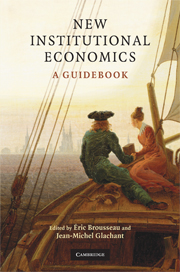Book contents
- Frontmatter
- Contents
- List of tables
- List of figures
- List of contributors
- Acknowledgements
- Foreword
- A Road Map for the Guidebook
- Introduction to New Institutional Economics: A Report Card
- Part I Foundations
- Part II Methodology
- 5 The “Case” for Case Studies in New Institutional Economics
- 6 New Institutional Econometrics: The Case of Research on Contracting and Organization
- 7 Experimental Methodology to Inform New Institutional Economics Issues
- 8 Game Theory and Institutions
- Part III Strategy and Management
- Part IV Industrial Organization
- Part V Institutional Design
- Part VI Challenges to Institutional Analysis
- Notes
- References
- Index
8 - Game Theory and Institutions
Published online by Cambridge University Press: 06 July 2010
- Frontmatter
- Contents
- List of tables
- List of figures
- List of contributors
- Acknowledgements
- Foreword
- A Road Map for the Guidebook
- Introduction to New Institutional Economics: A Report Card
- Part I Foundations
- Part II Methodology
- 5 The “Case” for Case Studies in New Institutional Economics
- 6 New Institutional Econometrics: The Case of Research on Contracting and Organization
- 7 Experimental Methodology to Inform New Institutional Economics Issues
- 8 Game Theory and Institutions
- Part III Strategy and Management
- Part IV Industrial Organization
- Part V Institutional Design
- Part VI Challenges to Institutional Analysis
- Notes
- References
- Index
Summary
Introduction
Since the seminal book by Von Neumann and Morgenstern (1944), Theory of Games and Economic Behavior, game theory has progressively permeated all fields of economics (industrial organization, labor, financial and international economics) and extended its influence on the other social sciences (politics, sociology, and law). It has become an essential tool for studying interpersonal relationships and provides a rigorous and useful methodology for modeling and analyzing strategic decisions. Game theory methodology has also incited profound and far-reaching changes in the way markets, organizations, and institutions are viewed; it has contributed to better understanding the rationale of many private and public institutions, such as contracts, franchising, insurance, certification agencies, and standardization committees.
This chapter is aimed at revealing the contribution of game theory to the analysis of institutions. The goal herein is not to propose an exhaustive course in game theory (for good introductions to game theory, see Gibbons 1992 or Osborne and Rubinstein 1995), but rather to focus on the main results and lessons that can be drawn from game theory with respect to institutions.
Institutions may basically be characterized in two ways. They can, first, be defined as the set of fundamental political, social, and legal ground rules that establish the bases for production, exchange, and distribution (Davis and North 1971). From this perspective, institutions appear as the rules of the game imposed on all economic actors.
- Type
- Chapter
- Information
- New Institutional EconomicsA Guidebook, pp. 158 - 180Publisher: Cambridge University PressPrint publication year: 2008
- 3
- Cited by

